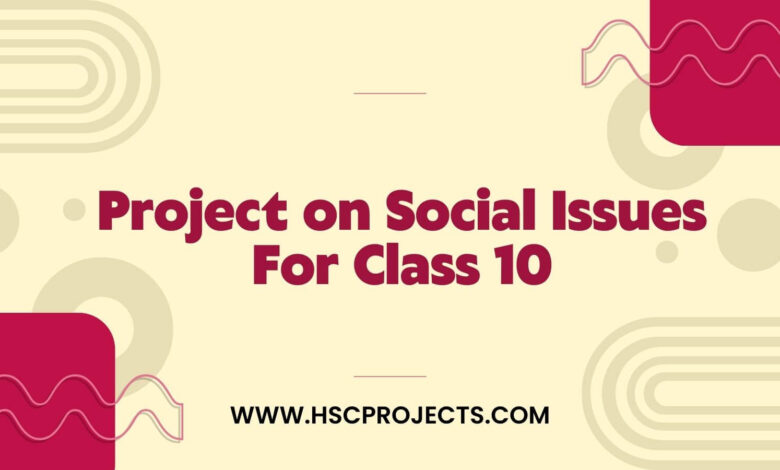
Project On Social Issues Class 10
Introduction
A social issue is one that has widespread public attention. It’s not uncommon for people and communities to suffer as a result of problems with the economy, the government, culture, or the environment. Poverty, inequality, prejudice, environmental degradation, and lack of access to excellent education and healthcare are only few examples of broader societal problems. Social problems are intricate and multidimensional, necessitating cooperation between citizens, organisations, and governments. Awareness and action on social problems are necessary steps towards creating a more equal and just society.
Classification Of Social Issues
There are several ways to categorise social problems depending on their characteristics and levels of impact. Common ways of categorising societal problems are as follows:
Economic issues: Poverty, income inequality, unemployment, and lack of access to basic essentials like food, shelter, and healthcare are all examples of economic challenges.
Political issues: Corruption, discrimination, human rights violations, and a lack of representation or involvement in decision-making are all examples of political concerns.
Cultural issues: Racism, sexism, homophobia, religious intolerance, and a lack of a common language are all examples of cultural difficulties.
Environmental issues: Climate change, pollution, deforestation, and the exhaustion of natural resources are all examples of environmental problems that fall within the broader category of social concerns relating to the natural world and the effects of human action on it.
Health issues: Access to healthcare, drug misuse, mental health stigma, and contagious infections are all examples of health concerns that affect society.
These categories are not exclusive of one another, and many societal problems fall under more than one. To effectively solve social problems, it is important to first understand the many forms they might take.
Consequence
The effects of social problems on both people and groups may be profound. The following are examples of the effects of societal problems:
Economic costs: Social problems with economic repercussions include poverty, unemployment, and inequality. Lost productivity, slower economic development, and higher costs for social services are all possible outcomes of the problems we’ve identified.
Health problems: Social difficulties may have negative consequences on health as well. Lack of access to medical care, clean water, and adequate sanitation, for instance, may contribute to the proliferation of several infectious diseases. Mental health and wellbeing may be negatively affected by discrimination and stigma.
Social unrest: Inequality, discrimination, and political persecution are all factors that may contribute to social discontent. Protests, rioting, and possibly civil war, are possible outcomes.
Environmental degradation: Social problems including overcrowding, poverty, and a lack of access to education may have a negative impact on the environment. Deforestation, climate change, and other environmental problems are the outcome.
In sum, social problems may have extensive and lasting effects on both people and groups. To lessen their effects and advance a more equal and just society, it is crucial to take swift and effective action.
History
Problems with society have always been present in human culture. Cultural, economic, and political factors have always determined the kind of social problems encountered by a given society at any given time in history. The following are some instances of persistent societal problems throughout history:
Slavery: The transatlantic slave trade period was not the first time where the slavery of individuals because of their race or ethnicity was a major societal problem.
Gender inequality: women have historically had less access to resources including higher education, stable work, and political participation due to bias based on their gender.
Poverty: Chronic poverty has plagued human society for centuries, leaving many people and whole communities unable to provide for their most fundamental necessities.
Civil rights: The ability to vote, equal opportunities in education and work, and freedom from discrimination are all examples of civil rights that have been fought for by different groups at different times in history.
As civilizations have advanced, societal problems have grown in scope and complexity. There is a vast variety of societal problems that must be addressed immediately. We may learn more about the origins of societal problems and create more effective solutions if we look at their historical context.
Current
Our modern civilization is plagued by a number of serious societal problems. The following are examples of some of the most pressing societal problems today:
Climate change: An urgent global societal concern, climate change affects people everywhere. Its causes—human actions like burning fossil fuels and cutting down trees—have far-reaching effects on the natural world and people’s health and quality of life.
Inequality: As a result of prejudice and a lack of access to resources and opportunities, inequality is still a major problem in today’s society. Disparities in wealth, education, and other material conditions are included in this category.
Mental health: Many people nowadays struggle with mental health issues including anxiety and depression, making mental health a pressing public concern. Problems associated with mental health may be made much worse by stigma and a lack of readily available services.
Immigration: In recent years, immigration has become a divisive and contentious societal topic. Border security, resettlement of refugees, and the handling of those who are in the country illegally are all examples of immigration-related issues.
Health and healthcare: When it comes to matters of health and medicine, many people still have restricted access to necessary treatment because of financial constraints. The need of healthcare infrastructure and preparation has also been brought to light by the COVID-19 pandemic.
These are only few of the numerous contemporary socioeconomic problems. A more fair and equitable society can only be achieved by the persistent work of people, governments, and other stakeholders to address these problems.
Stakeholders
People or organisations with a vested interest in seeing a social problem resolved are considered stakeholders in that issue. Stakeholders, while discussing social problems, might include:
People and groups: People and groups are often the ones who feel the effects of social problems the most acutely. They have a personal stake in resolving these problems for the sake of their own and others’ happiness.
Non-governmental organizations (NGOs): NGOs, or “non-governmental organisations,” are nonprofit groups that use lobbying, research, and direct service to tackle societal problems. They may be essential in bringing attention to societal problems and pushing for legislative changes.
Governments: Governments have a duty to address social concerns via policymaking, financial support, and the provision of services. Health, education, and welfare policies fall under this category.
Private sector: Corporate social responsibility (CSR) initiatives, philanthropy, and collaborations with non-governmental organisations (NGOs) and governments are all examples of how the business sector may help find solutions to societal problems.
International organizations: The United Nations and the World Health Organisation are only two examples of international organisations that may help combat worldwide socioeconomic problems. They may help finance initiatives to address social challenges, provide technical assistance, and advocate for change.
By working together, advocating for change, and pooling resources, stakeholders can tackle complex societal problems. Stakeholders must accept responsibility for their part in solving societal problems and collaborate to achieve common goals.
Solutions
When attempting to solve societal problems, it’s important to bring together a wide range of people and perspectives. Possible answers to societal problems might consist of:
Policy shifts: changes in policy at the regional, national, and global levels may assist alleviate societal problems. Policies in the fields of healthcare, education, and social welfare, for instance, may aid in the fight against inequality and the spread of equal chances.
Community engagement: Participation from members of the community is crucial while trying to solve societal problems. It entails helping people and groups find answers that are tailored to their own problems. Community-based initiatives, public engagement, and bottom-up organising are all viable options here.
Advocacy and awareness-raising: Advocacy and awareness-raising may assist bring attention to social problems and push for positive legislative changes. Social media, mainstream media, and local events are all tools that may be used for this purpose.
Research and data analysis: Analysis of data and research into the origins of societal problems may lead to the creation of effective, data-driven remedies. This may need the use of surveys, data analysis, and collaboration with academics and think tanks.
Partnerships and collaboration: Collaboration and partnership between different groups may help solve societal problems more efficiently. To do so, it may be necessary to combine resources and expertise among NGOs, governments, private sector organisations, and international organisations.
To solve social problems, many people and organisations must work together persistently. Understanding the complexities of social problems and creating solutions that are specific to the needs of those impacted is crucial.
Case Studies
The Flint Water Crisis: The Flint water crisis started in 2014, when the city of Flint, Michigan began using the Flint River as its primary water supply. There was a public health crisis because lead and other contaminants had leached into the water supply. The disaster underlined the necessity for government accountability and openness and the need of having access to clean water.
Black Lives Matter Movement: The Black Lives Matter movement arose in protest against police brutality and institutionalised racism that disproportionately affects people of African descent in the United States. Issues of police reform, racial inequity, and social justice have all been brought to the forefront by the movement.
Me Too Movement: The “Me Too” campaign was started in 2017 in response to the widespread problem of sexual harassment and assault in the workplace. There has been a larger discussion about consent, power dynamics, and responsibility as a result of the movement.
COVID-19 Pandemic: Social concerns relating to healthcare, inequality, and access to resources have been brought to light by the COVID-19 epidemic. As a result of the pandemic’s disproportionate effect on vulnerable populations, more equitable healthcare and social welfare policies are urgently needed.
StopAsianHate Movement: The #StopAsianHate campaign began after a spike in hate crimes in the United States targeted Asian people. Racism and prejudice against Asians are becoming topics of discussion thanks to the campaign.
These examples show how difficult and pressing societal problems may be, and how constant work is required to find solutions. They also show how effective social movements and group efforts can be in bringing about change.
Conclusion
Social problems have many facets and influence people on the micro, meso, and macro levels. Inequality, prejudice, and a dearth of available resources and opportunity are only a few potential causes.
Changes in legislation, community involvement, lobbying, research, and cooperation are just few of the methods that may be used to tackle societal problems. Individuals and communities impacted must have their specific needs addressed and common goals and objectives established.
The case studies in this project show how effective collective action and social movements can be in bringing about change, highlighting the critical nature of tackling social concerns immediately. They also stress the significance of government accountability, openness, and stakeholder participation in the fight against social problems.
In the end, it is up to everyone—individuals, communities, governments, and other stakeholders—to work together to find solutions to societal problems. Together, with a holistic perspective, we can build a more fair and equitable society.
Certificate
I, [Your Name], a student of Class 10 at [Your School Name], am proud to present my project on “Social Issues. ” This project delves into various societal challenges that have a profound impact on people and communities. Through extensive research and analysis, I have explored the complexities of these issues and proposed possible solutions to create a more equitable and just society.
Throughout this project, I have learned about the classification of social problems, which includes economic, political, cultural, environmental, and health-related issues. Understanding these categories has helped me grasp the different dimensions and levels of impact that social problems can have on society.
I have also delved into the consequences of social issues, realizing the far-reaching effects they can have on economic growth, health, social harmony, and the environment. These effects are not limited to individuals but also impact communities and the world at large.
Exploring the history of social problems has given me valuable insights into the persistence of certain challenges across generations. The fight for civil rights, gender equality, and against slavery serves as a reminder that social progress is an ongoing journey.
In the current context, I have examined some of the most pressing societal problems, such as climate change, inequality, mental health issues, immigration, and healthcare disparities. These issues are relevant to the contemporary world, and addressing them requires collective effort.
As I presented various case studies, such as the Flint Water Crisis, Black Lives Matter Movement, Me Too Movement, COVID-19 Pandemic, and StopAsianHate Movement, I have come to appreciate the power of social movements and community engagement in bringing about positive change.
I want to thank my teacher for guiding me throughout this project and for instilling in me a passion for understanding and addressing societal challenges. I am also grateful to my family and friends for their support and encouragement.
By creating this project on “Social Issues, ” I aim to raise awareness about the urgent need for action and collaboration to solve societal problems. I believe that with the collective effort of individuals, governments, NGOs, and other stakeholders, we can build a better and more inclusive world.
[Your Name][Class 10, CBSE][Your School Name][Date]In order to download the PDF, You must follow on Youtube. Once done, Click on Submit
Follow On YoutubeSubscribed? Click on Confirm
Download Project On Social Issues Class 10 PDF






